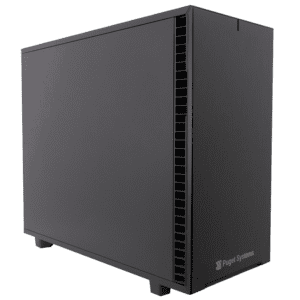I had the opportunity to take a day with Brett Nordquist yesterday, and attend the Geekwire Summit in downtown Seattle. The sessions ended up repeatedly circling back to the overwhelming proliferation of mobile devices. Todd Bishop said something I entirely agree with. “Of course we’re in a post-PC era! Why are we arguing about it?” he said. “But that doesn’t mean the PC is dead.” Exactly! Clearly the technology world is changing. But what does that mean for PCs?
Gaming Computers: Its All About Balance
We sell all sorts of computers here at Puget Systems, and one of the more popular requests is for a gaming computer. In fact, we have designed one of our main brands around gaming – the Puget Deluge is an excellent system to consider for a gaming rig. Some gamers come to us already knowing what specs they want, but others are seeking more detailed guidance on what processor, video card, and other components to go with. The exact advice we give depends on the situation: the sorts of games they are interested in, the screen resolution they plan to run, their budget, and other preferences. However, a lot of that advice can be distilled down into the following basic principles.
A New Age of Advertising
Over the last few days, I’ve been taking some time to update the documentation of the Puget Systems marketing and advertising strategy. I’m finding that what I am really doing is documenting the culture of the company, because the way we approach advertising is a good window on the way we run our business. We are sometimes asked “Why haven’t I seen advertisements of your company?” That is a great question. What the inquirer is really trying to determine is whether Puget Systems is a legitimate, successful business. Most of the most successful PC manufacturers canvas heavily with advertisements, from magazine ads to website banners. Isn’t Puget Systems successful as well? If Puget Systems is successful, where are our advertisements? In answering these questions, we have a great opportunity to talk about something that makes Puget Systems special.
Gaming Performance with Dual Monitors
Many of the computers we sell here at Puget Systems will be used for playing games, and we also get a lot of folks wanting to run two (or more) monitors. Sometimes those goals intersect, and in those situations I have had people ask if they needed to get a second video card so that using additional monitors will not impact their performance for gaming. I myself use two monitors here at work, which has been a great improvement in usability, but I don’t play games in the office. Because of that I’ve had to fall back on anecdotal evidence when this topic comes up, and make educated guesses depending on individual scenarios. Rather than continue in that approach, though, I wanted to get hard numbers to support my advice.
How We are Handling the Hard Drive Shortage
Widespread flooding in Thailand is affecting millions of people there, and has shut down many thousands of factories. In the computer industry, this is creating a severe hard drive shortage. Some manufacturers (such as Western Digital) are directly affected, with plants in Thailand that are shut down. In addition, many hard drive component suppliers are also impacted by the flooding, extending the reach of this shortage to all hard drive manufacturers.
Spanning Multiple Monitors
Early this year, I decided to purchase and setup a trio of monitors for a triple monitor display. The setup itself was going to be used in a span configuration with a resolution of 5760 x 1080 on an ATI 5870 Eyefinity Edition video card with the goal of being able to see more while gaming. I thought I’d share my experiences, and what I learned may help you with your own monitor configuration.
PCI-Express Performance and the NVIDIA Warning
Puget Systems has been in the business of building computers for 11 years now, and we know what we are doing when it comes to assembling top-notch custom computers. It is a bit insulting, then, when a parts manufacturer puts out a warning which appears – on the surface – to indicate something we do is resulting in anything other than the highest performance possible. Yet here I am, to let you know about just such a notice that nVidia’s latest driver software is giving when using their graphics cards in certain configurations.
H67, P67, and Z68 – Which one is right for you?
Intel’s Sandy Bridge processor architecture is turning 6 months old in July, and has been a major seller in the PC market in these few short months. There was a slight hiccup a month after it was released, when it was found that there was a defect in the SATA controller of the chipsets designed to work with these processors, but that has long since been resolved and no further problems have arisen.
How is the Tablet Market Affecting Puget Systems?
Yesterday Gartner released a report that worldwide PC shipments fell in the first quarter of 2011. As I read over the article I couldn’t help but compare this current state of the PC industry as a whole to that of Puget Systems.
Custom vs. Closed Loop Liquid Cooling
As a custom computer manufacturer, we’ve sold liquid-cooled systems from well before I joined the company. A water-based coolant is able to transfer heat away from hot components like the processor (CPU) and video card (GPU) more quickly than air alone would. That added cooling is appealing for folks who want to push their systems beyond design specifications. Overclocking ability is perhaps the most the most tangible benefit of liquid-cooling, but there are other reasons some folks are interested in it: liquid-cooling can make a computer look very stylish, for example, or allow operation of more hot-running components than a chassis could normally keep cool.
